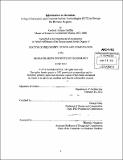| dc.contributor.advisor | George Stiny. | en_US |
| dc.contributor.author | Griffith, Kenfield A. (Kenfield Allistair) | en_US |
| dc.contributor.other | Massachusetts Institute of Technology. Dept. of Architecture. | en_US |
| dc.coverage.spatial | nwtr--- f-ke--- f-tz--- | en_US |
| dc.date.accessioned | 2012-09-13T18:53:52Z | |
| dc.date.available | 2012-09-13T18:53:52Z | |
| dc.date.copyright | 2012 | en_US |
| dc.date.issued | 2012 | en_US |
| dc.identifier.uri | http://hdl.handle.net/1721.1/72820 | |
| dc.description | Thesis (Ph. D. in Design and Computation)--Massachusetts Institute of Technology, Dept. of Architecture, 2012. | en_US |
| dc.description | Cataloged from PDF version of thesis. | en_US |
| dc.description | Includes bibliographical references (p. 155-159 (i.e. [190]-[194])). | en_US |
| dc.description.abstract | Remote design comes with significant challenges. A major barrier to designing in remote regions is the lack of communication between designers and users. As a result, the lack of information flow leads to assumptions about the community's needs- an inherent weakness in the design process. This study examines the role that mobile phones play as a mode of communication between designers of products for communities in developing countries and the users within the communities themselves, in order to provide a better sense of context and environment. This study focused on the use of a communication software called mSurvey and its ability to create accessible feedback flows, that would otherwise be difficult to achieve within remote areas. The investigation uses three case studies as examples. These case studies differ in location, design team, and distance. The first case study took place in Trinidad and Tobago and had software engineers as the design team. The second case study, in Nairobi, Kenya, consisted of architects, engineers, and Masters of Business Administration (MBAs) as the design team. The third case study, in Tanzania, consisted of a company of over 160 employees, whose job titles ranged from designers and engineers, to supply chain strategists. The findings illustrate that, although each design task was different, there are similar challenges when designing for remote regions, specifically, developing countries. The solution to some of these challenges is the increased use of mobile technologies between designers and communities. | en_US |
| dc.description.statementofresponsibility | by Kenfield Allistair Griffith. | en_US |
| dc.format.extent | 159 (i.e. [194]) p. | en_US |
| dc.language.iso | eng | en_US |
| dc.publisher | Massachusetts Institute of Technology | en_US |
| dc.rights | M.I.T. theses are protected by
copyright. They may be viewed from this source for any purpose, but
reproduction or distribution in any format is prohibited without written
permission. See provided URL for inquiries about permission. | en_US |
| dc.rights.uri | http://dspace.mit.edu/handle/1721.1/7582 | en_US |
| dc.subject | Architecture. | en_US |
| dc.title | Information to iteration : using information and communication technologies [ICT] in design for remote regions | en_US |
| dc.title.alternative | Using information and communication technologies [ICT] in design for remote regions | en_US |
| dc.type | Thesis | en_US |
| dc.description.degree | Ph.D.in Design and Computation | en_US |
| dc.contributor.department | Massachusetts Institute of Technology. Department of Architecture | |
| dc.identifier.oclc | 806474212 | en_US |
